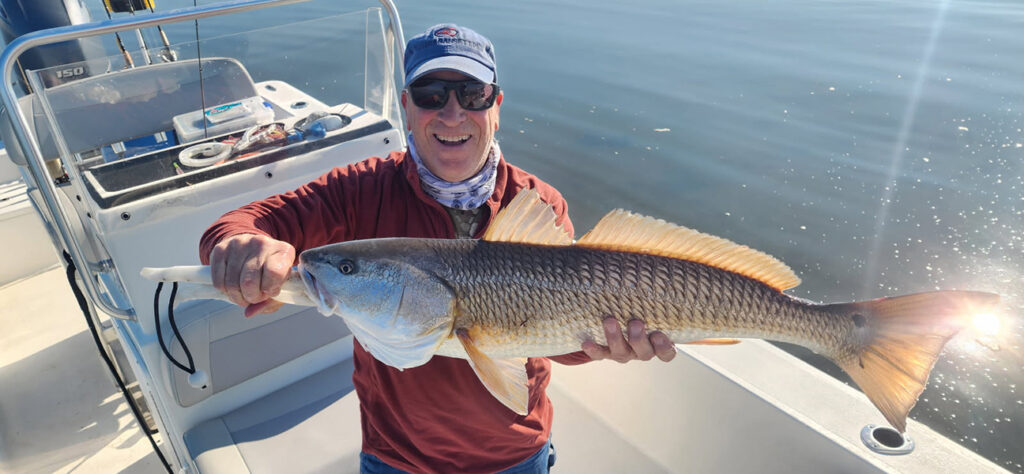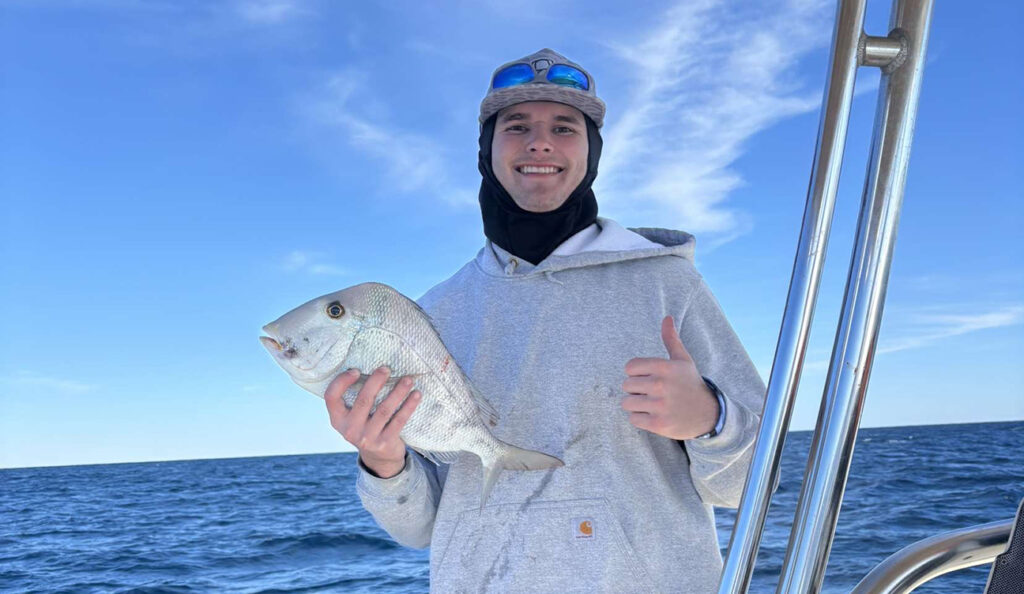Wrightsville Beach – April 2025
Tex, of Tex’s Tackle, reports that surf anglers are happy to see catches of Virginia mullet, bluefish, and the occasional red drum.
Inshore anglers have continued to find success targeting red drum and black drum in the backs of creeks and around the same structures they have moved between all winter. Both drum species should start to scatter into the ICW in April.
Off the beach, black sea bass fishing has been good in the 15-20 mile range. The numbers are strong, and the sizes vary from shorts to jumbos.
Closer to the beach, a few scattered bluefish are being found, and anglers await the arrival of Atlantic bonito.
The Gulf Stream action has been productive, with wahoo and blackfin tuna as the main targets.
Ben, of Intracoastal Angler, reports that inshore water temperatures have slowly started warming up, but the red drum mostly remain in their winter patterns. The reds have been holding in the backs of creeks and on flats (the shallower, warmer waters). Z-Man soft plastics on Ned rigs work well, as does dead shrimp, when fishing around structure.
Some reds are being caught at the Masonboro jetties. They’re hitting both bottom-rigged shrimp and Gulp or Z-Man soft plastics on heavier jig heads.
Fishing shrimp at the jetty is producing a few speckled trout and sheepshead.
Surf anglers are slowly starting to see Virginia mullet show up.
Off the beach, Atlantic bonito are beginning to pop up in the 5-10 mile range. As these fish push in, trolling with Clarkspoons, Drone spoons, and Yo-Zuri deep diver plugs will be great options to locate the schools.
Black sea bass fishing remains strong out in the 20-mile range.
Anglers looking to make a Gulf Stream run are finding the wahoo action worth the trip. A few blackfin tuna are mixed in.

William D, of Colorado, landed this 30″ red drum in the ICW behind Wrightsville Beach using jigs. He was fishing with Capt. Tommy Mungo of Mungo Fishing Charters.
Luke, of Coastline Fishing Charters, reports that red drum and black drum are still staged up around docks in the ICW and mainland creeks. The tactic for these fish is simple: a piece of shrimp on a Carolina rig will get some bites. In the coming weeks, these fish start to break out into smaller groups, and that’s when the bite picks up quite a bit. This action usually happens around the same time the water clarity moves away from “gin clear.”
Speckled trout are scattered around areas closer to the inlet.
Nearshore, some gray trout are starting to show up. The numbers haven’t been anything spectacular just yet, but the fish are there.
Pierre, of Rising Sun Fishing, reports that inshore water temperatures are hovering on the cool side (54-58 degrees), and this has fish still in their winter patterns.
Black drum can be found with relative reliability using dead shrimp around rocks, oysters, and docks.
Red drum fishing has been decent, with anglers having success fishing natural baits (dead shrimp, live mud minnows, or cut mullet) around docks in the ICW. Artificials can be productive, too, but natural baits are a little better right now. The incoming tide has been the better bite.
Some speckled trout are mixed in during low tide.
Gray trout are starting to pick up around the nearshore reefs as they push into the area. Larger soft plastics or even metal jigs will have success with the gray trout.
Anglers are waiting for the Atlantic bonito to show up, and this usually happens when the area sees 62-64 degree water temperatures.
Guion, of Green Creek Outfitters, reports that inshore fishing remains good for anglers targeting red and black drum. Both species are being found in shallow bays and around nearby structure in mainland creeks. Using natural baits such as cut mullet or shrimp has been key since these fish have seen so much pressure over the past few months. A lightly weighted Carolina rig is best, as it hits the water softly and falls through the water column more slowly which avoids spooking the fish.
Anglers look forward to the Atlantic bonito showing up. The water temperatures have moved into the upper 50s, so it shouldn’t be long.

Matthew Bauldree, of Raleigh, caught this porgy offshore of Wrightsville Beach using a cigar minnow.
Victor, of Carolina Charters, reports that inshore anglers are having some success catching black drum and smaller sheepshead around docks and bridge structure.
Out at the jetties, a few smaller sheepshead are active, but nothing else is worth noting just yet.
Red drum continue to hold in their winter schools throughout the mainland creeks. Carolina-rigged shrimp fished in holes or around structure as the tide falls has been the best tactic for the reds.
Rick, of Living Waters Guide Service, reports that offshore trolling action is centered around wahoo and blackfin tuna, with the possibility of yellowfins showing at any time.
Jigging trips are producing blackfin tuna, amberjacks, African pompano, and rainbow runners.
The area could start seeing early mahi action by mid-April.
Ben, of Southern Run Fishing Charters, reports that anglers are starting to see a better wahoo bite out in the Gulf Stream, with some blackfin tuna mixed in.
Nearshore areas haven’t quite seen water temperatures change enough for any fishing action to pick up. For now, bottom fishing for black sea bass in the 80’ range remains the most productive option.
Atlantic bonito are slowly starting to make their way inshore, with some schools being found over the deeper wrecks in 80-100’ of water.
Mike, of Johnnie Mercers Pier, reports that the season is just starting to kick off, with catches of pufferfish, croakers, and sea mullet coming off of a variety of bottom-rigged baits.
